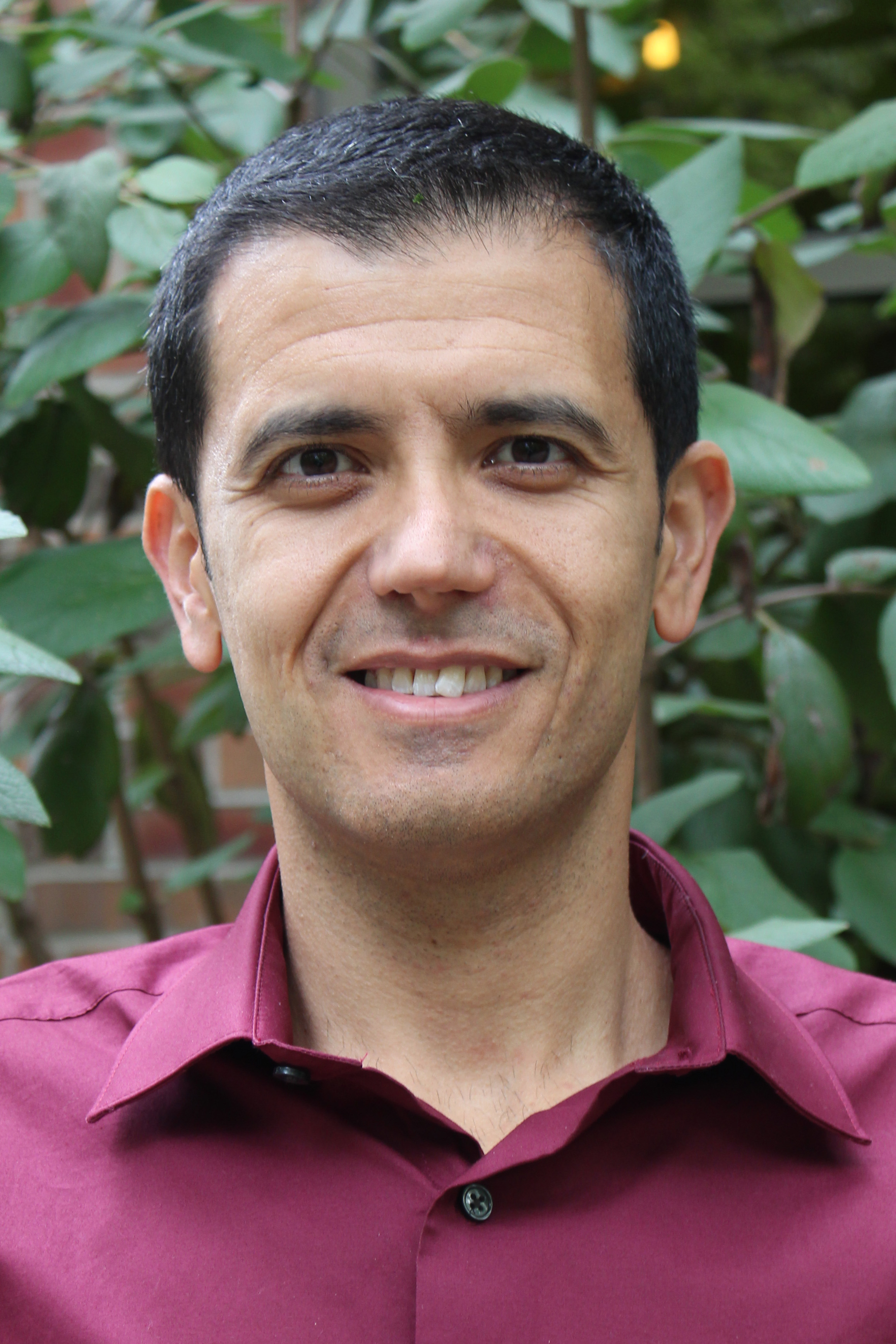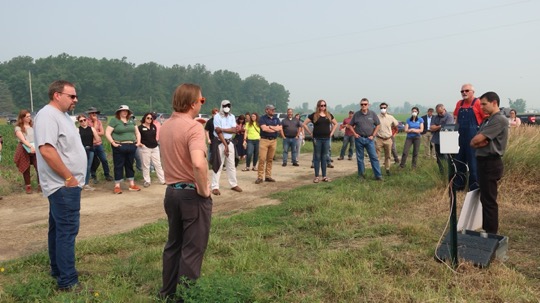MSU researcher examines agricultural conservation practices to reduce environmental impact on Great Lakes
Ghane receives $1.2 million MDARD funding for continued water quality research

 August 2, 2023 - For about two decades, annual algae blooms fed primarily by nutrient runoff from sources like agricultural fields, animal facilities and wastewater treatment plants have developed in the western portion of Lake Erie.
August 2, 2023 - For about two decades, annual algae blooms fed primarily by nutrient runoff from sources like agricultural fields, animal facilities and wastewater treatment plants have developed in the western portion of Lake Erie.
Algal blooms occur when nutrients (primarily phosphorus in Lake Erie), warm water and adequate light create optimal growing conditions, producing visible colonies in ponds, lakes and other water bodies.
Some types of algal blooms, referred to as harmful algal blooms (HABs), produce toxins that are harmful to human health and wildlife and threaten the water quality of the lakes. In the Western Basin of Lake Erie, blooms of blue green algae called cyanobacteria can produce toxins that can kill fish, mammals, birds, and can cause human illness.
According to a study by the National Oceanic and Atmospheric Administration, harmful algal blooms cause approximately $82 million annually in economic losses in fishing and tourism in the Great Lakes region.
Together with farmers and agricultural stakeholders across Michigan, and supported by partnerships with the Michigan Department of Agriculture and Rural Development(MDARD) and Michigan Department of Environment, Great Lakes, and Energy (EGLE), MSU AgBioResearch scientist Ehsan Ghane is exploring practices he hopes will assist Michigan farmers in abiding by what he calls, the golden rule of drainage drain only what is necessary for crop production and not a drop more.
Ghane, associate professor and MSU Extension specialist in the Department of Biosystems and Agricultural Engineering, focuses his research and outreach efforts on agricultural water quality and quantity. His goal is educating stakeholders (e.g. producers, drainage contractors, crop advisors, conservation professionals, and agency personnel) to increase the performance and profitability of subsurface drainage systems, while reducing harmful water-quality impacts.
Ghane and his research team recently received a $1.2 million grant from MDARD to continue a project called Edge-of-Field with the objective to investigate the effectiveness of conservation drainage practices.

'there is good understanding and best management practices around addressing the movement of surface runoff from farmland, but this is not so true for water moving through tile lines, said MDARD Environmental Stewardship Division (ESD) Director James Johnson. The important research being done by Ehsan Ghane and his team at MSU is helping us to better understand tile-line movement of nutrients in water. This will allow for the development of a best management plan that advocates for drainage control structures, as well as a management system for controlling the release of water from those structures.
ESD plans to use information gleaned from the study to develop farmer education to better control nutrient and water releases in the short term, and ultimately use these plans as part of the Michigan Agriculture Environmental Assurance Program verification process, Johnson added.
The grant will fund continued data collection and management implementation on three partner farms in the River Raisin Watershed. Ghane's project is testing the effectiveness of two types of water management systems controlled drainage and saturated buffers to see how they are best implemented and how much phosphorus can be reduced and kept out of surface water.
We want to show how effective these practices are and show farmers how beneficial they are, so we can encourage people to implement them. We eventually want farmers to adopt these practices voluntarily to improve water quality and their crop yield, Ghane said.
Partnering with Michigan farmers
The project consists of two sites with controlled drainage and one site with a saturated buffer. The project will monitor nitrate, total phosphorus and dissolved reactive phosphorus in subsurface drainage discharge from each drainage system to compare to a control field consisting of free drainage systems.
Our research is conducted on privately owned farmland and we partner closely with the landowners, the farmers, and the producers, Ghane said. We share data with them and they share their farming practices with us, so we both learn from each other. Our partnership with the farmers is a critical component of this research.
John Tuckerman, a fifth-generation corn, wheat and soybean farmer from Lenawee County, has partnered with MSU researchers since the early 1980s.
Tuckerman, an MSU graduate in Food Systems Economics and Management, said his partnership with MSU AgBioResearch and MSU Extension has helped his operation grow and modernize, as well as provided an opportunity to participate in research aimed at improving Michigan's land and environment.

I have concern about the phosphorus load Michigan's farms are contributing to Lake Erie, and because of that, I was a happy participant in this project, Tuckerman said. I'd like to learn how to do things better to help figure out how to mitigate the situation. I think by doing this research and proving that it won't hurt yields and that we save phosphorus, we will be able to get more buy-in from other farmers.
Controlled drainage the process of adjusting the outlet elevation of a drainage system to control the volume of water leaving the field and reduce nutrient loss provides the capability to better manage water resources on the farm.
Saturated buffers use the same principles as controlled drainage systems, but in addition the system intercepts water from the tile drainage and reroutes and treats it through soils and vegetation before exiting into an adjacent waterway.
Data collection from the previous five years on partner farms has shown as much as 25% phosphorus loss reduction using these drainage methods compared to control fields. Researchers believe these methods have potential to capture even more than the initial studies indicate.
MDARD partnership key to future success
Joe Kelpinski serves as a program manager for MDARD's Environmental Stewardship Division leading the Michigan Agricultural Environmental Assurance Program. His team works closely with Michigan's agriculture communities and commodity groups to promote agricultural growth in a way that's going to be protective of the environment and specifically of our state's water resources.
Our mission is to work with farms of all types, sizes, and commodities to promote a voluntary, proactive environmental program to protect the environment and our water, said Kelpinski, who provides guidance to the state's agricultural communities on implementation of effective drainage and conservation methods and techniques. Michigan is a water rich state, and the Great Lakes are part of our economy, culture and identity, so it's vital for the state to support efforts to protect the lakes. MDARD appreciate the ongoing research partnership with MSU.
Variations in rainfall, temperature and numerous other factors impact nutrient loads entering surface water each year. More years of data collection will lead to more effective practices being implemented with the goal of ultimately reducing the phosphorus load entering Lake Erie by 40%.
I know everyone would love to see the algae bloom issues fixed yesterday. I want them fixed yesterday; but the reality is, Ehsan is doing the fundamental research to answer questions to help us make real change in Michigan's portion of the Western Lake Erie Basin or in Saginaw Bay. This partnership helps us get a deeper and connected handle on water quality issues that are so important to us all, Kelpinski said. Michiganders identify with the Great Lakes. It's woven into our culture and it's a fundamental piece of who we are, and so keeping the lakes clean is important to everyone and we're committed to making a real, substantial difference.



 Print
Print Email
Email




